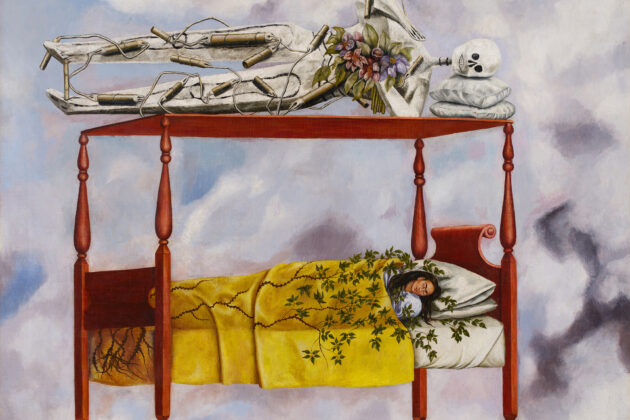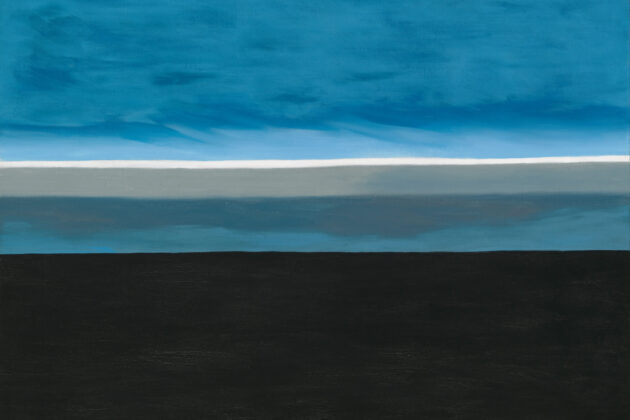
The History and Conservation Journey of “Cross with Red Heart, 1932” by Georgia O’Keeffe
Join Dale Kronkright, Head of Conservation at the Georgia O’Keeffe Museum, as he shares the fascinating story behind Georgia O’Keeffe’s 1932 oil painting Cross with Red Heart and how his technical study of the work led to incredible findings.
In the summer and fall of 1932, Georgia O’Keeffe was involved in a heated dispute with her husband, Alfred Stieglitz, about a large mural she hoped to paint at Radio City Music Hall in New York. O’Keeffe skipped her annual trip to New Mexico and instead twice fled Manhattan to explore the remote, rural regions of Québec and the Gaspé Peninsula to reset her visual and creative horizon. Photographer Paul Strand, O’Keeffe’s colleague within Alfred Stieglitz’s gallery of artists, had traveled to Québec and Nova Scotia in 1919, 1920, and to the Gaspé Peninsula in 1929, producing striking landscapes, seascapes, and abstractions. Following Strand’s lead, O’Keeffe’s travels were facilitated by the recently completed, 553-mile road that ringed the Gaspé Peninsula. Like Strand, O’Keeffe found the sturdy white barns, the sea, and the green landscapes of Québec to be fit subjects for her paintings. But as in New Mexico, O’Keeffe also painted two, outdoor, wayside French-Canadian crosses. Cross with Red Heart began as her tallest work to date, at seven feet high, and features a blood-red heart, surrounded by a circular nimbus of spear-pointed projections and dark-brooding clouds overhead. The painting would thus begin a surprising journey from Manhattan to, in the 1960’s, a trustee for the Whitney Museum who would adopt the painting as the consecrated cross for the Sacred Heart Catholic Church in Margaretville, New York.
This presentation dives deeper into the story of this painting and how the technical examination of its canvas, priming, and paints, along with the careful study of its condition and exhibition history, led Head of Conservation Dale Kronkright to remarkable discoveries that resulted in its eventual loan and exhibition at the Georgia O’Keefe Museum.
—
This talk was recorded as part of our free Mornings with O’Keeffe lecture series on the first Wednesday of every month.
About the Speaker:
Dale Kronkright has been Head of Conservation at the Georgia O’Keeffe Museum since its inception in 1997. Dale began research into O’Keeffe’s studio materials and techniques in 2000 with scientists and conservators at the National Gallery of Art, resulting in the 2006 exhibition and catalog “Color and Conservation” which documented the 40-year friendship of conservator Caroline Keck and Georgia O’Keeffe.
His latest research on O’Keeffe’s studio materials and techniques was published in 2021 in the essay “An Intentional Language: The Studio Materials and Methods of Georgia O’Keeffe, 1915 -1975” in the 2020 exhibition catalog for Georgia O’Keeffe, at the Museo Nacional Thyssen-Bornemisza, in Madrid.
Dale earned his BA in American Culture Studies from the University of California at Davis and his postgraduate certificate in Conservation at the Peabody Museum, at Harvard. Prior to coming to work for the Georgia O’Keeffe Museum, Dale was Senior Conservator for the Museum of New Mexico, in Santa Fe for seven years and was Senior Conservator at the Regional Conservation Center, Bishop Museum, Honolulu for six years.
He has served as an instructor and author for the Getty Conservation Institute and as adjunct faculty at the Art Conservation Graduate Program at SUNY Buffalo and the Department of Art Conservation at the University of Delaware at Winterthur.


